
Keke Kaikhosroshvili
Keke is Zavvy's expert in learning experience. On our blog, she shares experience and insights based on her studies in learning design and experiences made with our customers.


"We all need people who give us feedback. That's how we improve," Bill Gates stressed in a 2013 TED talk.
Bill Gates is one of the most successful entrepreneurs of our time—when he speaks, people listen. He understands the value of feedback.
When done well, feedback promotes confidence, loyalty, and productivity in organizations. All of these are essential ingredients for a successful workplace.
This article will explore the types of feedback used in workplaces today—their strengths, weaknesses, and characteristics.
You might be undecided on which type of feedback makes the most sense to your organization and employees. We'll show you which type of feedback is most helpful in different situations.
Together with our curators, we have created a library of actionable digital marketing resources. Personalized to your team's needs.
If you're a people manager, it's essential to use the right kind of feedback to get the most from your team (and for your team to get the most from their experience at work).
While we look at different types of feedback, they all have one thing in common—the value that effective feedback brings to employee enablement and development.
Employee enablement means giving your employees everything they need to do their job to the best of their abilities. It also means creating an environment that allows them to perform optimally.
Effective feedback is essential for this.
More broadly, effective feedback provides benefits for employees and their organizations. According to Indeed, these include:
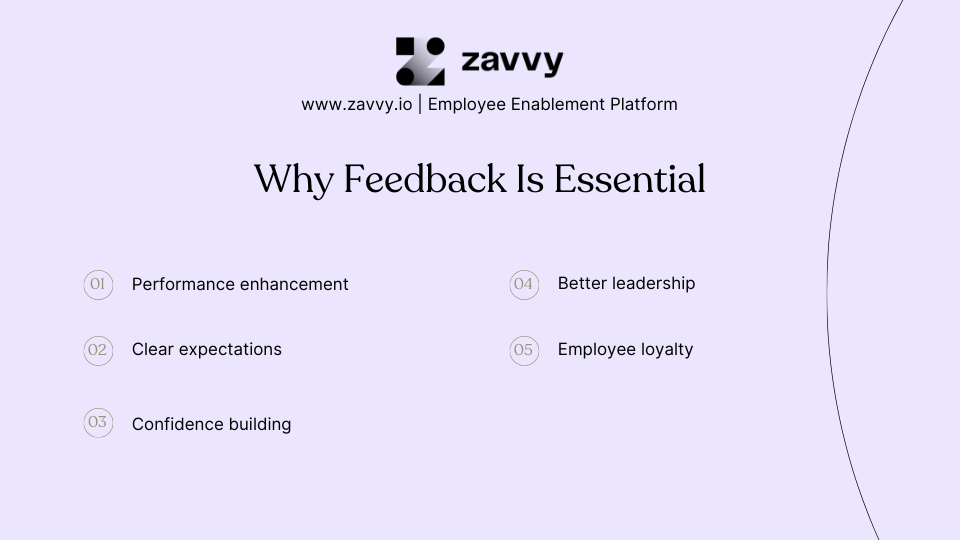
Feedback comes in many forms. It can vary, for instance, by:
We'll discuss several types of feedback in the following and group them based on content, direction, mode, time-frame, and purpose.
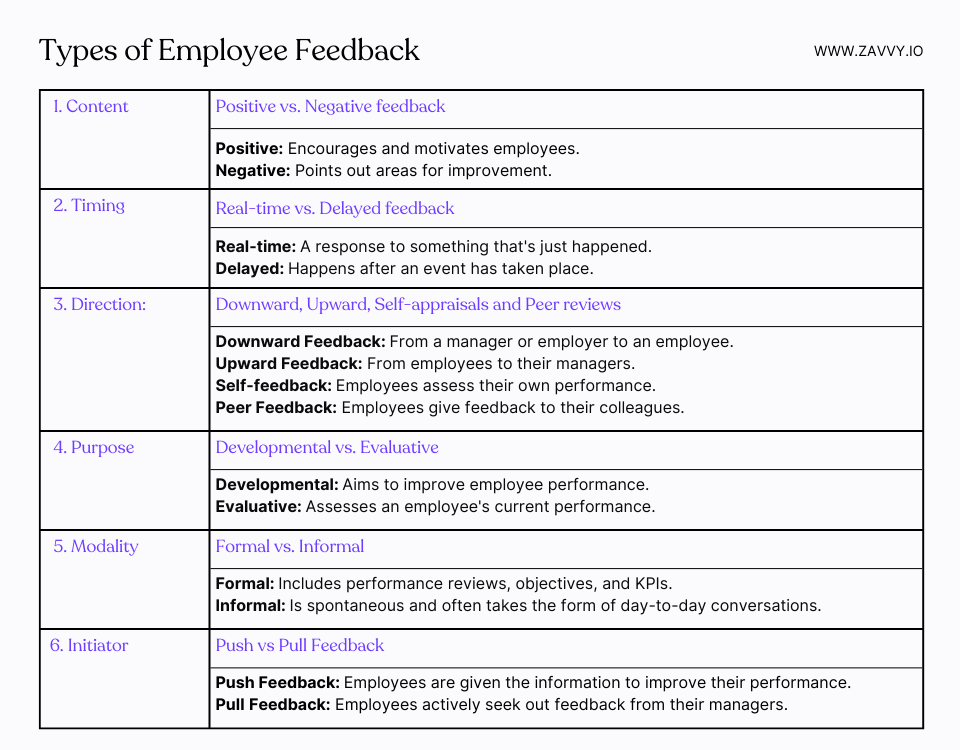
Nearly all feedback has either positive or negative content.
Positive feedback conveys appreciation, praise, and positive remarks. Plus, it encourages and motivates employees by highlighting their strengths and achievements.
Positive feedback also reinforces good behaviors and supports employees in their professional development.
Negative feedback conveys corrective or critical comments and is difficult for many employees to hear. It can make them feel attacked, undervalued, and demotivated.
Four out of five employees started looking for another job after negative feedback, according to Gallup's 2018 workplace survey.
However, negative feedback can be effective if it focuses on actions to change unsuccessful behaviors rather than criticisms.
Constructive feedback is closely related to negative feedback and focuses on identifying areas for improvement.
In fact, employees want constructive feedback in order to become better at their jobs and have better opportunities for career development.
Even when feedback is negative, 92% of respondents of an HBR survey believe that it is effective at improving performance if delivered appropriately (meaning, constructively).
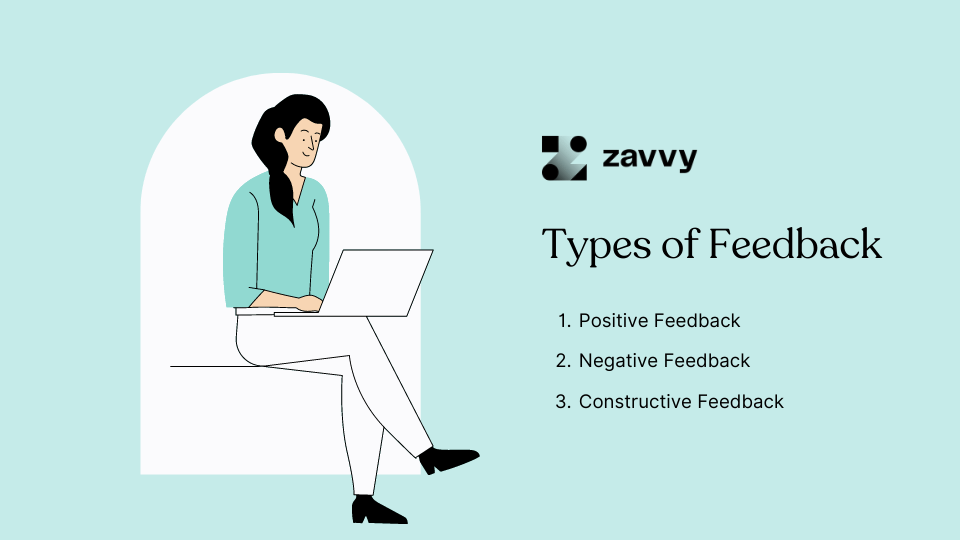
➡️ Struggling to find the right words to say? Here are 80 positive feedback and negative feedback examples.
The direction of feedback in a workplace can be:
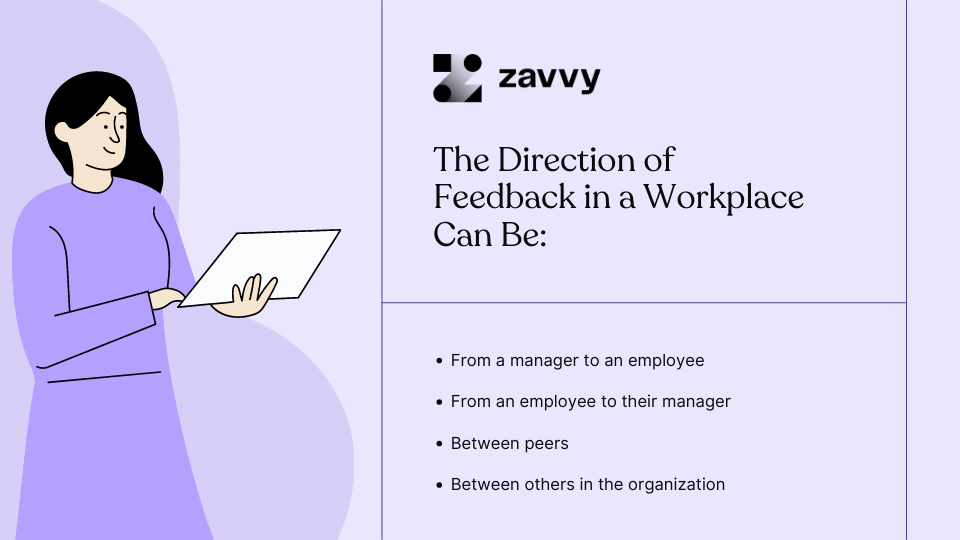
Downward feedback is when managers pass on their opinions and guidance to direct reports.
The flow of information is downward, i.e., from higher in the organizational structure (managers) to lower (direct reports).
Downward feedback is familiar in the workplace and often causes anxiety or fear—if a direct report feels they're about to be reprimanded or informed about a low bonus, for instance.
Upward feedback flows opposite to downward feedback, i.e., from direct reports to their managers. It's not very common and usually happens when managers ask for it rather than voluntarily.
Upward feedback promotes employee well-being by creating trust and psychological safety.
When asking for feedback from their direct reports (who may otherwise hesitate to provide it), managers show a willingness to listen and learn from their subordinates.
Peer-to-peer feedback and self-feedback are forms of feedback within the same layer of organizational hierarchy.
360-degree feedback is multi-directional, i.e., it flows in any direction between managers, supervisors, senior leadership, co-workers, and even customers. It's usually anonymous, encouraging more open and honest communication from those who may otherwise feel intimidated to give candid feedback.
360-degree feedback provides a well-rounded view of the attitudes and opinions of people across an organization, regardless of their roles. As a result, it paints a better picture of the strengths and weaknesses of the recipient compared with other kinds of feedback.
Feedback may have a formal or informal mode.
Formal feedback focuses on information-based observations and uses structured processes and frameworks.
Typically formal feedback is delivered during scheduled feedback sessions and involves performance reviews, objectives, and KPIs.
Formal feedback allows time for preparation and is evidence-based, but it may put a lot of pressure on employees.
Informal feedback, in contrast, has no set structure or feedback process. It's spontaneous and can be frequent. It occurs naturally, often through ad-hoc conversations in casual settings.
When informal feedback appears genuine, it helps to build a supportive working environment without the stress or anxiety of formal feedback. But being informal, there's no time to prepare the review, and it may not get the same acknowledgment as in a formal framework.
Coaching is a type of feedback that has elements of both formal and informal feedback. It's collaborative and hands-on, with the coach being a guide and teammate, creating a safe place for giving and soliciting feedback.
Coaching can be very effective and lead to quantifiable improvements across a variety of areas. BetterUp reported that, after receiving coaching, employees showed:
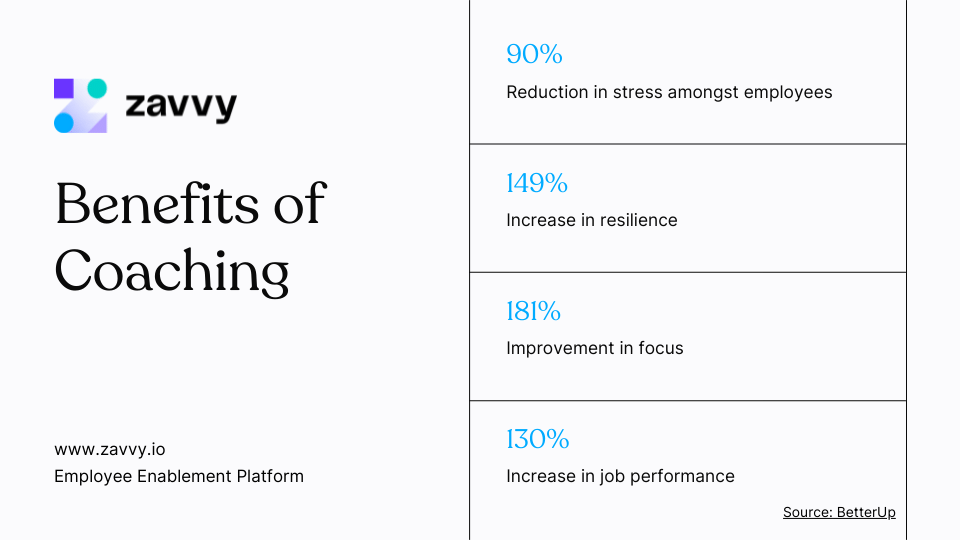
Beware: Some employees, however, may view coaching as micromanagement rather than a positive learning process and won't respond well to it.
While most feedback relates to past events, some forms of feedback relate to future or current events.
Forward feedback tells us about future behavior. It may be positive or negative, with affirming comments to motivate positive choices in the future or corrective statements to discourage undesirable behaviors.
Real-time feedback is for in-the-moment situations where a timely response is helpful. An example is when an employee makes a mistake but, with timely feedback, can correct it.
Finally, feedback can be viewed in terms of its purpose, as perceived by the feedback provider. The prominent psychologist, Carl Rogers, identified five types of feedback based on purpose, listed below from the most frequently used to the least frequent:
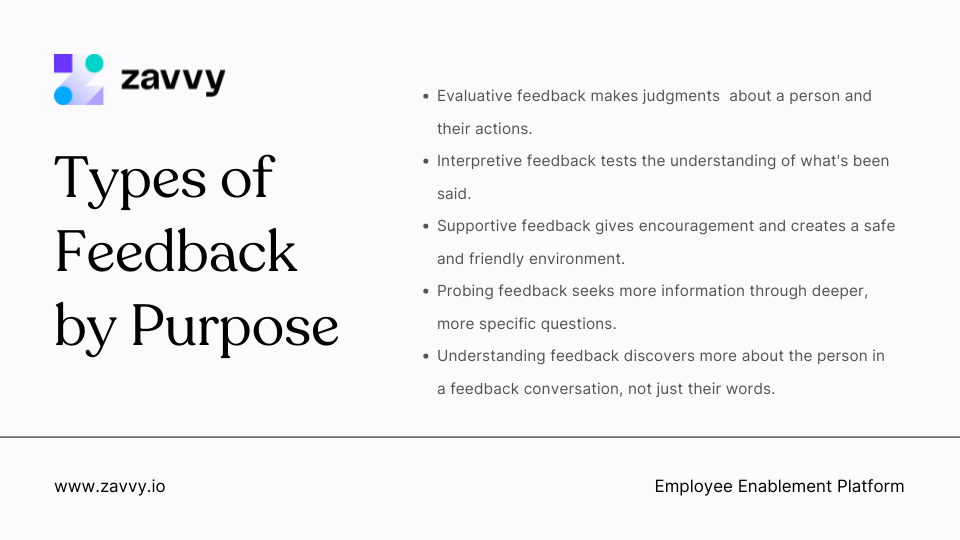
Evaluative feedback is often used in the workplace to objectively assess an employee's performance.
By setting goals, benchmarks, and timelines and then measuring progress against those, evaluative feedback offers an impartial basis for feedback discussions.
As we've seen, there are many types of feedback in the workplace, and each has different strengths and characteristics.
And there's often an overlap between types of feedback—downward feedback can be formal, for instance, conveying positive content, or informal feedback can be negative and between peers.
So, which type of feedback is most helpful? The answer is: it depends.
Different types of feedback are useful in different situations, and the most helpful feedback depends on the circumstances.
HR has a pivotal role in how feedback flows in an organization. Your influence on leaders, managers and people-management processes means you can promote the right kinds of feedback at the right times.
With this in mind, let's look at common workplace scenarios and identify the most helpful type of feedback in each case.
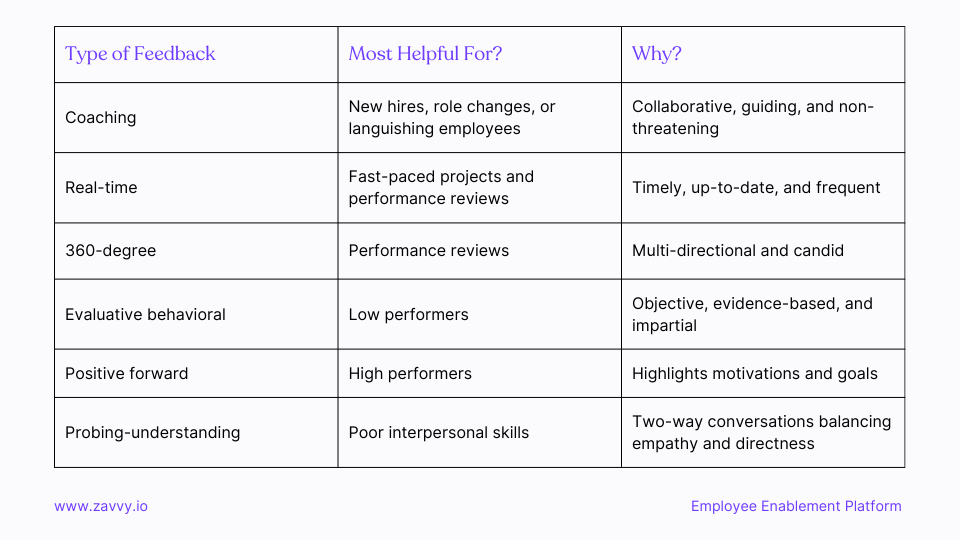
Coaching feedback is a good choice when new or existing employees start new roles since it gives them valuable, hands-on direction.
The collaborative, guiding and non-threatening approach of coaching feedback is beneficial during times of significant change.
Coaching feedback also helps those employees who feel like they're languishing in their careers.
Coaches are well-placed to identify what's holding employees back or affecting their well-being.
For example, BetterUp found that its members experienced a 38% decrease in languishing after just three months of coaching.
In busy, time-sensitive project environments, real-time feedback comes into its own. It's an ongoing, timely feedback form that works well in fast-moving environments.
For example: If your company is deploying a major systems project, and there's an issue preventing a smooth launch, then real-time feedback (i.e., that identifies and corrects the issue) can make the difference between success and failure.
Real-time feedback is also helpful during performance reviews, as it drives stronger engagement. Plus, due to its timely nature, employees and their managers get more up-to-date and frequent feedback than periodic reviews.
Plus, regular feedback leads to better employee engagement, which is always a bonus!
In fact, many companies, such as Accenture, have abandoned annual performance reviews in favor of real-time feedback.
360-degree feedback is another type of feedback that's helpful during performance reviews.
360-degree feedback strengthens teamwork and accountability while revealing specific career development areas, according to Susan Heathfield, an experienced HR consultant and author.
Plus, you can also take advantage of 360-degree feedback for leadership development. Jack Zenger, a global expert on organizational behavior, points out that:
"More than 85% of all the Fortune 500 companies use the 360-degree feedback process as a cornerstone of their overall leadership development process."
Giving feedback to low-performing employees is difficult. The conversations are uncomfortable and may even be emotive and upsetting. When dealing with low performers, Marcel Schwantes, a leadership and human-centered workplaces expert, suggests using an objective, evidence-based, and impartial approach.
Behavioral evaluative feedback, therefore, helps deal with low performers. It focuses on actions (driven by behaviors) rather than the person. Plus, it follows up with objective improvement measures and action points. Constructive feedback may also help if delivered well, as does a supportive and open communication process.
Compared to low performers, it's easy giving feedback to high performers. Or is it?
Amy Gallo, an author and speaker on workplace dynamics, explains that high performers may not receive feedback well if there's any suggestion of criticism.
But even high performers need a degree of constructive feedback.
But the emphasis, suggests Gallo, should be on the positive feedback that highlights motivations and goals with a focus on the future. Positive forward feedback, therefore, is helpful for high performers.
➡️ Do you need extra inspiration for giving feedback to your high performers? Check out 35 constructive feedback examples for high performers.
Workplace feedback is mostly given rather than sought. This, according to a Gallup survey, may explain why feedback isn't always effective.
Only 26% of employees strongly agree that feedback helped them do better at work.
One way to improve this is to ask for feedback rather than offer it.
Think, for example, when an employee or manager needs direction on their career, workplace behavior, or a project.
In these situations, upward or downward feedback initiated by the person receiving it is most helpful.
And as mentioned, when managers ask for upward feedback, they create trust and reduce anxiety in their direct reports.
Asking for feedback sets up a feedback dynamic that boosts engagement and improves business outcomes.
Interpersonal skills, or soft skills, are important in the workplace and relate to behaviors rather than knowledge.
But soft skills are notoriously hard to develop, points out Anne Fisher, a Fortune Magazine columnist.
But Chris Musser, Teaching Assistant at Harvard's Kennedy School, highlights that people can improve their interpersonal skills with proper feedback.
Musser suggests that feedback featuring dialog and investigation, two-way conversations, and a balance of empathy and directness is best for dealing with poor interpersonal skills.
Therefore, a mix of probing and understanding feedback, with carefully delivered constructive feedback, is helpful in these situations.
While the above list isn't exhaustive nor definitive, it should give you a good idea of how different types of feedback can be helpful in different situations.
Now that we've discussed several types of feedback, are you ready to give and receive effective feedback? Or, perhaps, to guide others—leaders, managers, and employees—on how to give valuable feedback?
Drawing on decades of experience, Susan Heathfield suggests that, whatever its type, effective and helpful feedback needs to be:
.png)
➡️ Still in need of ideas and tips? Check out our 20 best practices for employee feedback to create an engaging workplace culture.
We at Zavvy understand that proper feedback is essential for a well-performing workplace. It promotes a culture that fosters employee development and growth through the guidance, clarity, and confidence that effective feedback brings.
But as we've seen, feedback comes in many forms, and different types of feedback are helpful in different situations. So to make the most of feedback in your organization, you'll need a versatile and flexible approach.
At Zavvy, we can help you navigate, organize, and monitor a feedback framework that boosts performance. Our tools and programs will work seamlessly with your existing information flow while letting you fully customize them to your organization's needs.
Book a free 30-minute demo to see how you can leverage the potential of your people through effective feedback.
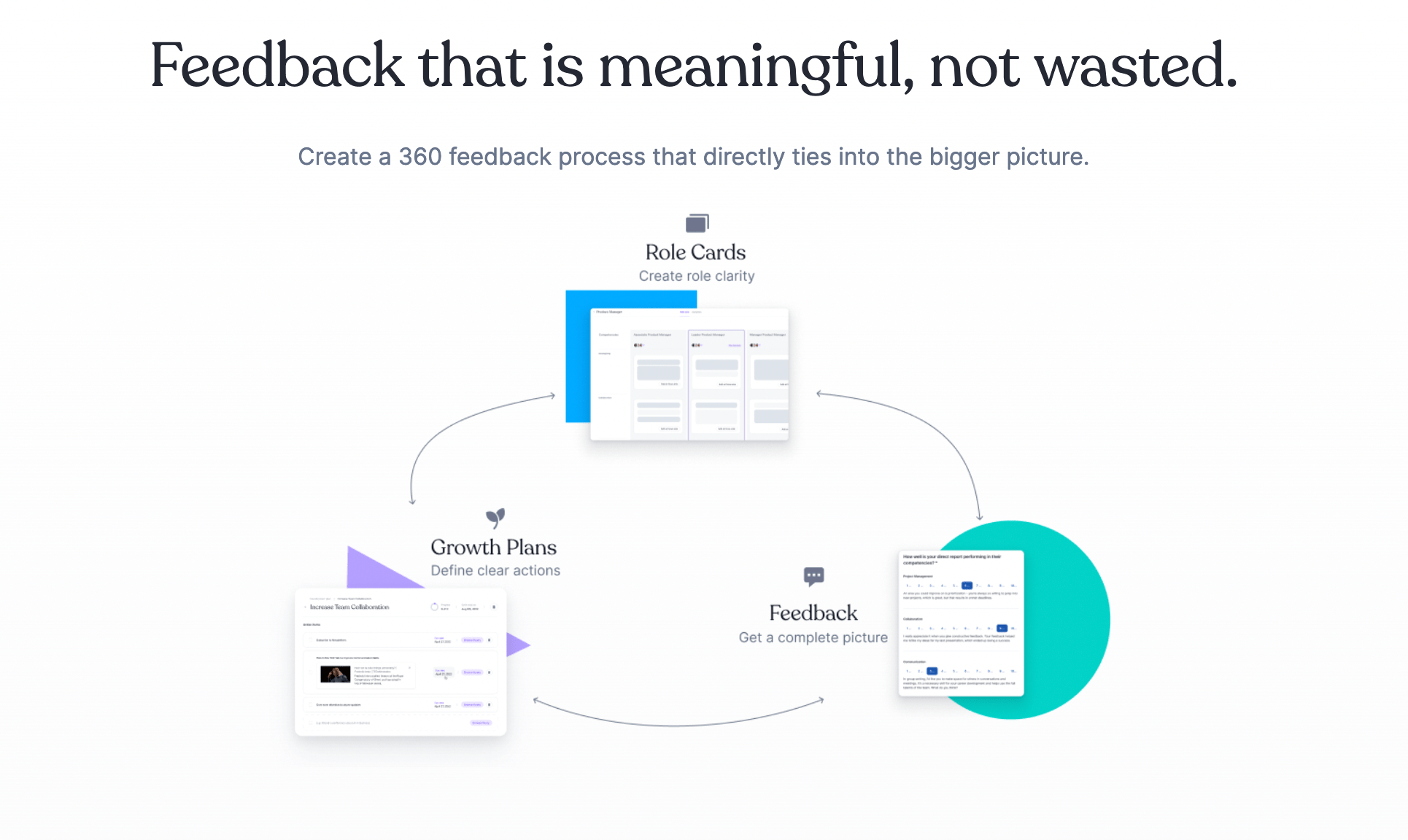
Upskill your team every week with the best contents and personalized recommendations.

"We all need people who give us feedback. That's how we improve," Bill Gates stressed in a 2013 TED talk.
Bill Gates is one of the most successful entrepreneurs of our time—when he speaks, people listen. He understands the value of feedback.
When done well, feedback promotes confidence, loyalty, and productivity in organizations. All of these are essential ingredients for a successful workplace.
This article will explore the types of feedback used in workplaces today—their strengths, weaknesses, and characteristics.
You might be undecided on which type of feedback makes the most sense to your organization and employees. We'll show you which type of feedback is most helpful in different situations.
Get a demo!
We'll be happy to show you around and answer all your questions.
Trusted by innovative companies



We'll be happy to show you around, answer your questions, or arrange a free trial.
Erhalten Sie eine kostenlose Demo unserer Onboarding-Software.
Vertraut von



Your Training & Development Strategy - Solved in 1 Tool.
Trusted by innovative companies



We'll be happy to show you around, answer your questions, or arrange a free trial.
Learn how Zavvy helps you drive performance, development, and engagement.
Trusted by innovative companies



We'll be happy to show you around, answer your questions, or arrange a free trial.
We'll be happy to show you around and answer all your questions.
Trusted by innovative companies



We'll be happy to show you around, answer your questions, or arrange a free trial.
Gerne zeigen wir Ihnen ganz unverbindlich unsere Plattform im Detail.
Vertraut von modernen Unternehmen



Get a demo!
We'll be happy to show you around and answer all your questions.
Trusted by innovative companies



We'll be happy to show you around, answer your questions, or arrange a free trial.
Erhalten Sie eine kostenlose Demo unserer Software für Mitarbeiterenwicklung und Training.
Moderne Unternehmen
setzen auf Zavvy


